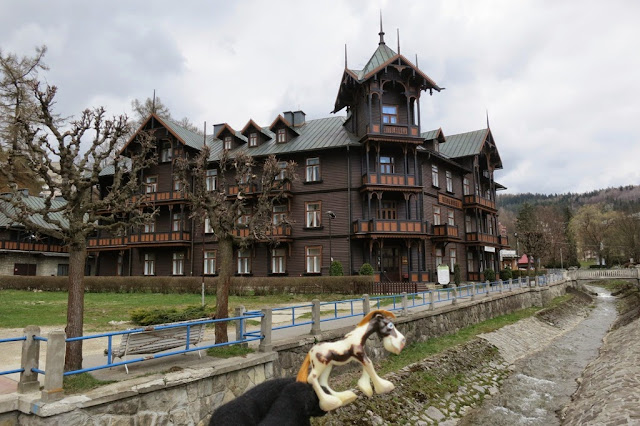And yes, we came here to see just one specific building. It looks quite modest from a distance.
Yet, the Saint Leonard church is one of the churches being part of the UNESCO World Heritage Site called Wooden Churches of Southern Małopolska.
And yes, you guessed it right, it is all built of wood. Even the roof is made of wooden shingle.
Today it serves mainly as a cemetery chapel.
Inside, the walls and the ceiling are also made of wood, with interesting paintings called polychrome.
In the back you will find a small gallery.
As you probably noticed, the church is rather dark inside. The reason for that is that, like many other churches built in the fifteenth century, the Saint Leonard church has only windows from the Southern side and has doors heading South and West. In the middle of the church comes a cross.
And in the front you will find, of course, the altar.
One amazing thing about the altar is that it is supported by a huge piece of wood that is well over a thousand years old and dates back to times when the inhabitants of this region were still pagan.
This wooden pillar was in fact a central place of worship of Slavic people living there centuries ago. When you look up, you will see a whole that was accommodating a second piece of wood - missionaries converting the region into Christianity turn it into a cross. Yet, when you look a bit down, you can still see some remaining of the old pagan god with four faces.
Next to the altar you can see some further religious paintings.
And behind it you may admire liturgical vestments called chasubles.
They are beautifully ornamented and come in different colours for different parts of the year.
Before we leave, I wanted to show you two things. This wooden plate says that the Saint Simon from Lipnica was praying there and managed to talk to one of the saints in the pictures. I will keep to myself my thoughts about people talking with paintings.
And here comes the UNESCO certificate.
Let's take one last glimpse at the Saint Leonard church from the outside - this time the North side (no windows as you see!).
You may see many similar churches across the Southern part of Poland. Not all of them are on the UNESCO list but to be honest they usually look very similar. Actually, you will have the same situation in the neighbouring Slovakia, where some of the churches are, again, inscribed on the list of UNESCO World Heritage while others do not. Even if they look great as well, just like this church of Immaculate Conception of Virgin Mary in Hraničné. We need to assume that UNESCO knows it best.
I hope that you have enjoyed this trip. But we are not yet done with wooden temples in Southern Poland. Watch out for our trip next week.

























































